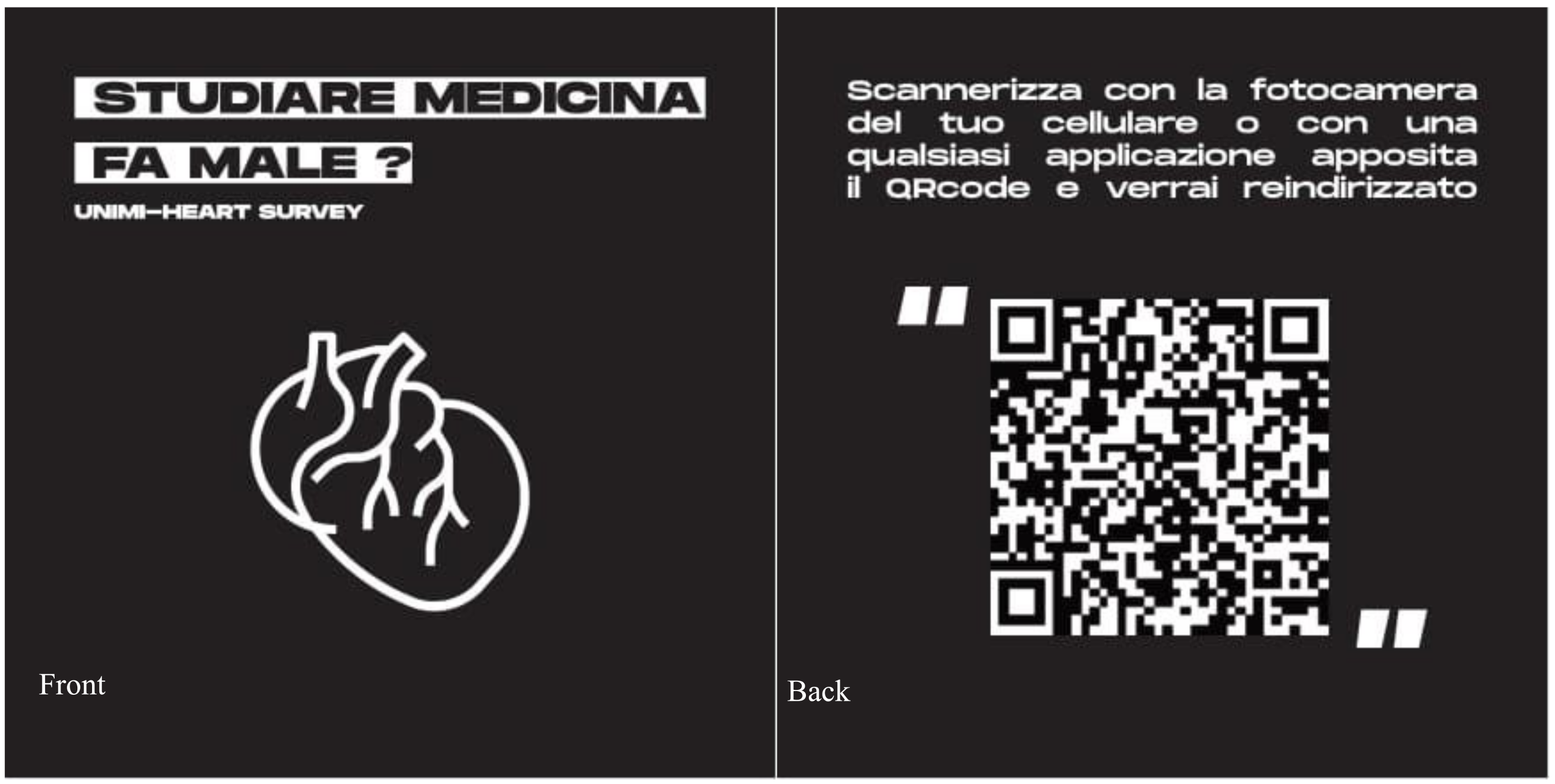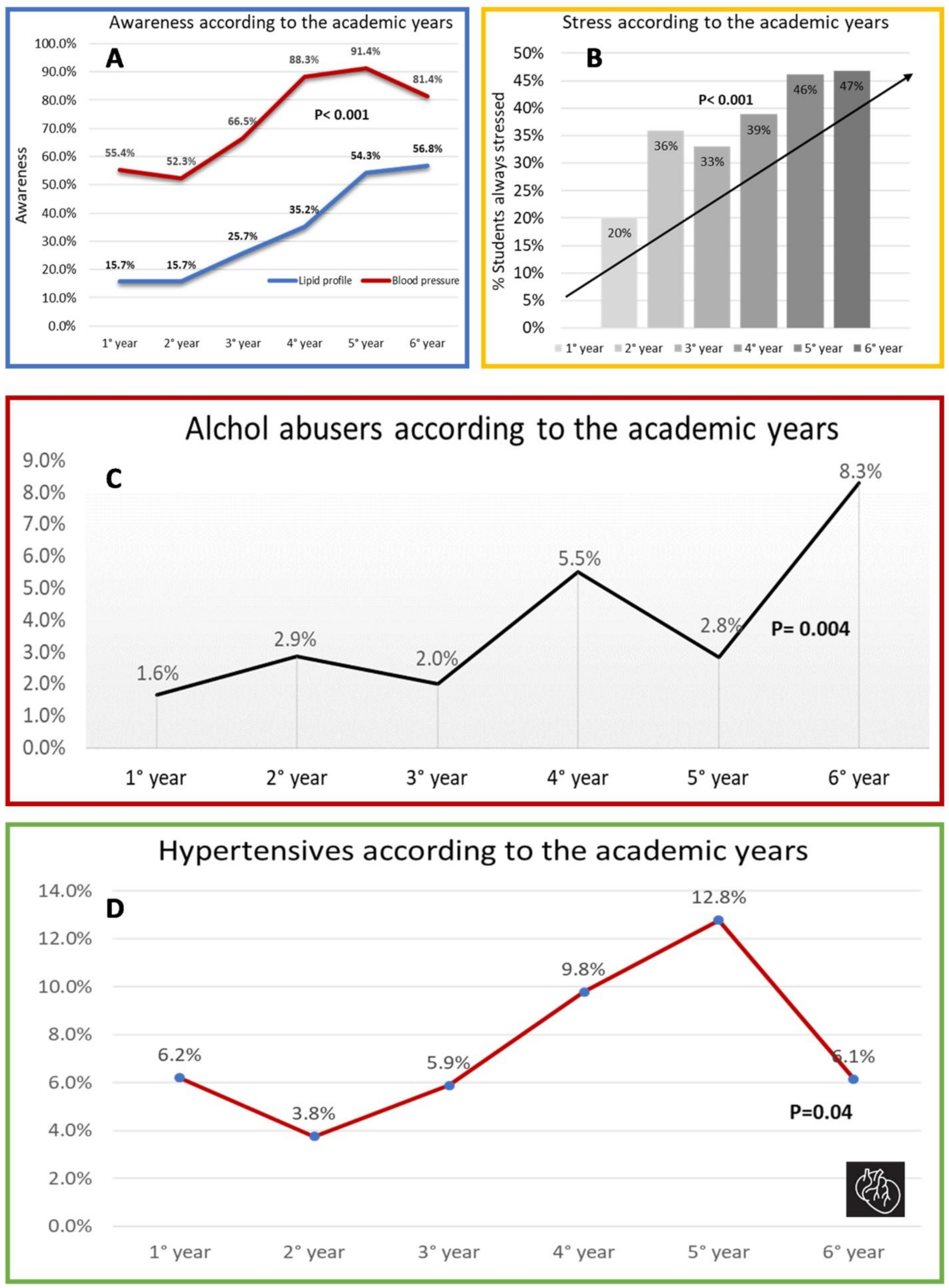Global Cardiovascular Risk Profile of Italian Medical Students Assessed by a QR Code Survey. Data from UNIMI HEART SURVEY: Does Studying Medicine Hurt?
Abstract
:1. Introduction
2. Materials and Methods
2.1. Questionnaire Administration and Recruitment
2.2. Questionnaire Characteristics
2.3. Statistical Analysis
3. Results
4. Discussion
Limitations and Strengths
5. Conclusions
Supplementary Materials
Author Contributions
Funding
Institutional Review Board Statement
Informed Consent Statement
Data Availability Statement
Acknowledgments
Conflicts of Interest
Abbreviations
| QR | quick response |
| CV | cardiovascular |
| BP | blood pressure |
| AHA | American Heart Association |
| BMI | body mass index |
| ESC | European Society of Cardiology |
| WHO | World Health Organization |
| LDL | low density lipoprotein |
| HF | heart failure |
References
- Piepoli, M.F.; Hoes, A.W.; Agewall, S.; Albus, C.; Brotons, C.; Catapano, A.L.; Cooney, M.T.; Corra, U.; Cosyns, B.; Deaton, C.; et al. 2016 European Guidelines on cardiovascular disease prevention in clinical practice. Eur. Heart J. 2016, 37, 2315–2381. [Google Scholar] [CrossRef] [PubMed]
- Haffner, S.M.; Stern, M.P.; Hazuda, H.P.; Mitchell, B.D.; Patterson, J.K. Cardiovascular Risk Factors in Confirmed Prediabetic Individuals. JAMA 1990, 263, 2893–2898. [Google Scholar] [CrossRef]
- Perrone, J.; Hollander, J.E.; de Roos, F. Cardiovascular Risk Factors and Atherosclerosis in Children and Young Adults. N. Engl. J. Med. 1998, 339, 1083–1084. [Google Scholar] [CrossRef]
- Loria, C.M.; Liu, K.; Lewis, C.E.; Hulley, S.B.; Sidney, S.; Schreiner, P.J.; Williams, O.D.; Bild, D.E.; Detrano, R. Early Adult Risk Factor Levels and Subsequent Coronary Artery Calcification. J. Am. Coll. Cardiol. 2007, 49, 2013–2020. [Google Scholar] [CrossRef] [PubMed]
- Gray, L.; Lee, I.-M.; Sesso, H.D.; Batty, G.D. Blood Pressure in Early Adulthood, Hypertension in Middle Age, and Future Cardiovascular Disease Mortality. J. Am. Coll. Cardiol. 2011, 58, 2396–2403. [Google Scholar] [CrossRef]
- Fuster, V.; Kelly, B.B. Promoting Cardiovascular Health in the Developing World: A Critical Challenge to Achieve Global Health; Academic Press: Washington, DC, USA, 2010. [Google Scholar]
- Evelyn, H.; Farahin, A.A. Associations of knowledge, attitude and practices (KAP) of food label on cardiovascular diseases (CVD) risk among University students in Selangor. Ann. Nutr. Metab. 2019, 66, S275–S282. [Google Scholar] [CrossRef]
- D’Agostino, E.; Patel, H.; Hansen, E.; Mathew, M.; Nardi, M.; Messiah, S. Effect of participation in a park-based afterschool program on cardiovascular disease risk among severely obese youth. Public Health 2018, 159, 137–143. [Google Scholar] [CrossRef]
- D’Agostino, E.M.; Patel, H.H.; Ahmed, Z.; Hansen, E.; Mathew, M.S.; Nardi, M.I.; Messiah, S.E. Impact of change in neighborhood racial/ethnic segregation on cardiovascular health in minority youth attending a park-based afterschool program. Soc. Sci. Med. 2018, 205, 116–129. [Google Scholar] [CrossRef]
- Enríquez, M.E.A.; Salas, F.J.U.; Baek, J.; Archbold, J.P.S.; Carrillo, G. Association between life-style behaviors and health outcomes in Adventist and non-Adventist adolescents in Mexico: A pilot study. BMC Public Health 2019, 19, 1–9. [Google Scholar] [CrossRef]
- Kilander, L.; Berglund, L.; Boberg, M.; Vessby, B.; Lithell, H. Education, lifestyle factors and mortality from cardiovascular disease and cancer. A 25-year follow-up of Swedish 50-year-old men. Int. J. Epidemiol. 2001, 30, 1119–1126. [Google Scholar] [CrossRef]
- Ficarra, M.G.; Gualano, M.R.; Capizzi, S.; Siliquini, R.; Liguori, G.; Manzoli, L.; Briziarelli, L.; Parlato, A.; Cuccurullo, P.; Bucci, R.; et al. Tobacco use prevalence, knowledge and attitudes among Italian hospital healthcare professionals. Eur. J. Public Health 2010, 21, 29–34. [Google Scholar] [CrossRef] [PubMed]
- Reiner, Ž.; Sonicki, Z.; Tedeschi-Reiner, E. The perception and knowledge of cardiovascular risk factors among medical students. Croat. Med. J. 2012, 53, 278–284. [Google Scholar] [CrossRef] [PubMed]
- Mach, F.; Baigent, C.; Catapano, A.L.; Koskinas, K.C.; Casula, M.; Badimon, L.; Chapman, M.J.; de Backer, G.G.; Delgado, V.; Ference, B.A.; et al. 2019 ESC/EAS guidelines for the management of dyslipidaemias: Lipid modification to reduce cardiovascular risk. Atherosclerosis 2019, 290, 140–205. [Google Scholar] [CrossRef]
- Stockwell, T.; Butt, P.; Beirness, D.; Gliksman, L.; Paradis, C. The basis for Canada’s new low-risk drinking guidelines: A relative risk approach to estimating hazardous levels and patterns of alcohol use. Drug Alcohol Rev. 2011, 31, 126–134. [Google Scholar] [CrossRef] [PubMed]
- Martínez-González, M.A.; García-Arellano, A.; Toledo, E.; Salas-Salvadó, J.; Buil-Cosiales, P.; Corella, D.; Covas, M.I.; Schröder, H.; Arós, F.; Gómez-Gracia, E.; et al. A 14-Item Mediterranean Diet Assessment Tool and Obesity Indexes among High-Risk Subjects: The PREDIMED Trial. PLoS ONE 2012, 7, e43134. [Google Scholar] [CrossRef]
- Temporelli, P.L.; Zito, G.; Faggiano, P. Cardiovascular Risk Profile and Lifestyle Habits in a Cohort of Italian Cardiologists (from the SOCRATES Survey). Am. J. Cardiol. 2013, 112, 226–230. [Google Scholar] [CrossRef]
- Lloyd-Jones, D.M.; Hong, Y.; Labarthe, D.; Mozaffarian, D.; Appel, L.J.; van Horn, L.; Greenlund, K.; Daniels, S.; Nichol, G.; Tomaselli, G.F.; et al. American heart association strategic planning task force and statistics committee defining and setting national goals for cardiovascular health promotion and disease reduction: The American heart association’s strategic impact goal through 2020 and beyond. Circulation 2010, 121, 586–613. [Google Scholar] [CrossRef]
- Hyre, A.D.; Muntner, P.; Menke, A.; Raggi, P.; He, J. Trends in ATP-III-Defined High Blood Cholesterol Prevalence, Awareness, Treatment and Control Among U.S. Adults. Ann. Epidemiol. 2007, 17, 548–555. [Google Scholar] [CrossRef] [PubMed]
- Zhang, Y.; Vittinghoff, E.; Pletcher, M.J.; Allen, N.B.; Al Hazzouri, A.Z.; Yaffe, K.; Balte, P.P.; Alonso, A.; Newman, A.B.; Ives, D.G.; et al. Associations of Blood Pressure and Cholesterol Levels During Young Adulthood with Later Cardiovascular Events. J. Am. Coll. Cardiol. 2019, 74, 330–341. [Google Scholar] [CrossRef]
- Pencina, K.M.; Thanassoulis, G.; Wilkins, J.T.; Vasan, R.S.; Navar, A.M.; Peterson, E.D.; Pencina, M.J.; Sniderman, A.D. Trajectories of Non–HDL Cholesterol Across Midlife. J. Am. Coll. Cardiol. 2019, 74, 70–79. [Google Scholar] [CrossRef] [PubMed]
- Maksimović, M.Ž.; Marinković, J.M.; Vlajinac, H.D.; Tomanić, M.S.; Radak, D.J. Awareness and knowledge of cardiovascular disease risk factors among medical students. Wien. Klin. Wochenschr. 2017, 129, 458–463. [Google Scholar] [CrossRef]
- Park, D.; Lee, J.-H.; Han, S. Underweight. Medicine 2017, 96, e8769. [Google Scholar] [CrossRef] [PubMed]
- Donfrancesco, C.; Ippolito, R.; Noce, C.L.; Palmieri, L.; Iacone, R.; Russo, O.; Vanuzzo, D.; Galletti, F.; Galeone, D.; Giampaoli, S.; et al. Excess dietary sodium and inadequate potassium intake in Italy: Results of the MINISAL study. Nutr. Metab. Cardiovasc. Dis. 2013, 23, 850–856. [Google Scholar] [CrossRef] [PubMed]
- Raitakari, O.; Juonala, M.; Kähönen, M. Cardiovascular risk factors in childhood and carotid artery intima-media thickness in adulthood. ACC Curr. J. Rev. 2004, 13, 77. [Google Scholar] [CrossRef]
- Mucci, N.; Giorgi, G.; Ceratti, S.D.P.; Fiz-Pérez, J.; Mucci, F.; Arcangeli, G. Anxiety, Stress-Related Factors, and Blood Pressure in Young Adults. Front. Psychol. 2016, 7, 1682. [Google Scholar] [CrossRef]
- Brazeau, C.M.; Shanafelt, T.; Durning, S.J.; Massie, F.S.; Eacker, A.; Moutier, C.; Satele, D.V.; Sloan, J.A.; Dyrbye, L.N. Distress Among Matriculating Medical Students Relative to the General Population. Acad. Med. 2014, 89, 1520–1525. [Google Scholar] [CrossRef] [PubMed]
- Mazurkiewicz, R.; Korenstein, D.; Fallar, R.; Ripp, J. The prevalence and correlations of medical student burnout in the pre-clinical years: A cross-sectional study. Psychol. Health Med. 2012, 17, 188–195. [Google Scholar] [CrossRef]
- Whitman, I.R.; Agarwal, V.; Nah, G.; Dukes, J.W.; Vittinghoff, E.; Dewland, T.A.; Marcus, G.M. Alcohol Abuse and Cardiac Disease. J. Am. Coll. Cardiol. 2017, 69, 13–24. [Google Scholar] [CrossRef]
- O’Connor, A.D.; Rusyniak, D.E.; Bruno, A. Cerebrovascular and Cardiovascular Complications of Alcohol and Sympathomimetic Drug Abuse. Med. Clin. N. Am. 2005, 89, 1343–1358. [Google Scholar] [CrossRef]
- Domínguez, F.; Fuster, V.; Fernández-Alvira, J.M.; Fernández-Friera, L.; López-Melgar, B.; Blanco-Rojo, R.; Fernández-Ortiz, A.; García-Pavía, P.; Sanz, J.; Mendiguren, J.M.; et al. Association of Sleep Duration and Quality with Subclinical Atherosclerosis. J. Am. Coll. Cardiol. 2019, 73, 134–144. [Google Scholar] [CrossRef]
- Faggiano, A.; Carugo, S. Can the implementation of electronic surveys with quick response (QR) codes be useful in the COVID-19 era? Int. J. Epidemiol. 2020, 49, 1732–1733. [Google Scholar] [CrossRef] [PubMed]




| PREDIMED Score | No. | (%) |
|---|---|---|
| Inadequate diet: score ≤ 5 | 121 | 10.3 |
| Intermediate diet: score 6–9 | 831 | 70.2 |
| Optimal diet: score ≥ 10 | 231 | 19.5 |
| Physical activity | ||
No physical activity:
| 387 | 32.7 |
Intermediate physical activity:
| 511 | 43.2 |
Optimal physical activity:
| 285 | 24 |
| Sleep time | ||
| <6 h | 190 | 16.1 |
| 6–9 h | 984 | 83.2 |
| >9 h | 9 | 0.8 |
| Number of 8 Main ¹ CV Risk Factors | No. (%) | Number of 12 Extended 2 CV Risk Factors | No. (%) |
|---|---|---|---|
| 0 | 495 (41.8%) | 0 | 333 (28.1%) |
| 1 | 432 (36.5%) | 1 | 403 (34.1%) |
| 2 | 198 (16.7%) | 2 | 260 (21.9) |
| ≥3 | 58 (4.9%) | ≥3 | 187 (15.9%) |
| Total | 1183 (100%) | Total | 1183 (100%) |
Publisher’s Note: MDPI stays neutral with regard to jurisdictional claims in published maps and institutional affiliations. |
© 2021 by the authors. Licensee MDPI, Basel, Switzerland. This article is an open access article distributed under the terms and conditions of the Creative Commons Attribution (CC BY) license (http://creativecommons.org/licenses/by/4.0/).
Share and Cite
Faggiano, A.; Bursi, F.; Santangelo, G.; Tomasi, C.; Sforza, C.; Faggiano, P.; Carugo, S. Global Cardiovascular Risk Profile of Italian Medical Students Assessed by a QR Code Survey. Data from UNIMI HEART SURVEY: Does Studying Medicine Hurt? J. Clin. Med. 2021, 10, 1343. https://doi.org/10.3390/jcm10071343
Faggiano A, Bursi F, Santangelo G, Tomasi C, Sforza C, Faggiano P, Carugo S. Global Cardiovascular Risk Profile of Italian Medical Students Assessed by a QR Code Survey. Data from UNIMI HEART SURVEY: Does Studying Medicine Hurt? Journal of Clinical Medicine. 2021; 10(7):1343. https://doi.org/10.3390/jcm10071343
Chicago/Turabian StyleFaggiano, Andrea, Francesca Bursi, Gloria Santangelo, Cesare Tomasi, Chiarella Sforza, Pompilio Faggiano, and Stefano Carugo. 2021. "Global Cardiovascular Risk Profile of Italian Medical Students Assessed by a QR Code Survey. Data from UNIMI HEART SURVEY: Does Studying Medicine Hurt?" Journal of Clinical Medicine 10, no. 7: 1343. https://doi.org/10.3390/jcm10071343
APA StyleFaggiano, A., Bursi, F., Santangelo, G., Tomasi, C., Sforza, C., Faggiano, P., & Carugo, S. (2021). Global Cardiovascular Risk Profile of Italian Medical Students Assessed by a QR Code Survey. Data from UNIMI HEART SURVEY: Does Studying Medicine Hurt? Journal of Clinical Medicine, 10(7), 1343. https://doi.org/10.3390/jcm10071343









